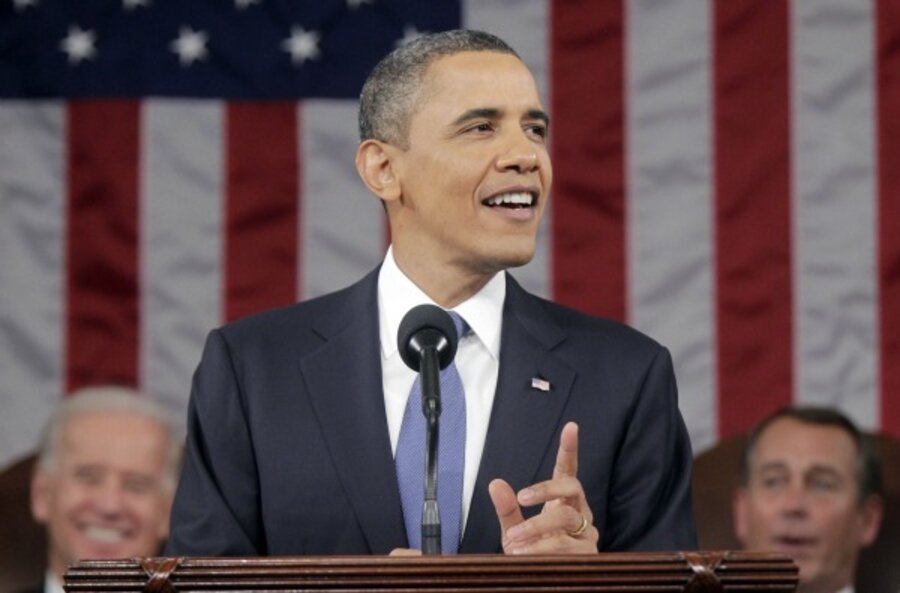State of the Union address: best and worst in history
Loading...
| Shepherdstown, W. Va.
After President Obama delivers his State of the Union address this evening, will Americans recall what he said?
The address is high political drama and marks one of the biggest nights of the year for the president, especially in a campaign year.
It is a command performance, mandated by the Constitution. It is also a tightrope act balancing the formal constitutional requirements with the strong desire to use this popular venue as a bully pulpit – to Congress, the American people, and the world.
Yet as the speech has evolved over the years, only a few memorable phrases and ideas have survived in the public consciousness. This is a result of the nature of this address, which traditionally has been more about reporting on administrative achievements and proposals the president plans to lay before Congress in the coming year.
Reaching back in American history, James Monroe in his 1823 annual message called for foreign powers to stay out of the western hemisphere, which became known as the Monroe Doctrine.
Lyndon Johnson first used the term “war on poverty” in his 1964 address. In George W. Bush’s 2003 address he included just 16 words on the topic of Saddam Hussein receiving shipments of uranium from Africa. Within months the US was at war with Iraq.
My picks for the worst and best personal results from a State of the Union message go to Grover Cleveland and Bill Clinton.
The worst outcome goes to Cleveland’s 1887 message, which, in those days was not delivered in person, but sent to Congress in writing. Instead of the usual list of administrative details, Cleveland used his message to outline plans for massive tariff reform. This plan so surprised and upset members of his Democratic Party that they split, leading to Cleveland’s defeat in 1888.
The finest personal hour for a State of the Union Address had nothing to do with the content of the speech, and everything to do with the circumstances surrounding the address and the public perception of the president’s performance.
On Jan. 19, 1999, on the very day that President Bill Clinton’s attorney opened the president’s impeachment defense in the Senate, Clinton came before Congress and delivered a cool and collected hour-long speech that made no mention whatsoever of his impeachment trial then dominating the news.
The goal of his speech and his performance was to demonstrate to the nation that despite his impeachment, he was still president and still conducting the nation’s business. Republicans and Democrats alike were impressed with this performance under extreme pressure.
In the television age the address has changed substantially from its original format. It has become a set piece, an annual ritual, a formalized occasion.
Harry Truman gave the first televised State of the Union address in 1947, in a dry-as-dust speech given at mid-day to a small television audience. Truman read his speech looking down at his prepared text much of the time. The Teleprompter had not yet been invented, and politicians had not adjusted to this powerful new medium of television.
Lyndon Johnson changed the time of the speech from high noon to prime time in 1965, to reach a larger audience.
These speeches have always been a complex political exercise, but modern addresses have taken on more partisan urgency. The address has become less about what the president actually says and more about how it is spun and re-interpreted through the press and through the members of Congress who respond to it.
Forty-three million Americans tuned in for Mr. Obama’s last State of the Union address. (Obama drew his largest audience of 70 million viewers with his 2008 election night speech in Chicago’s Grant Park.) These are huge numbers for a political event. But they don’t match the mother of all TV programs, the Super Bowl, which in 2011 had 111 million viewers. Nonetheless, no president can pass up the chance to speak to 40- or 50 million people.
In his speech tonight, Obama is expected to focus on the economy and themes such as education, clean energy, and American values. He will have to straddle governance and politics, without turning the address into a campaign stump speech. Still, just as Congress routinely declares the president’s budget to be dead on arrival when it gets to Capitol Hill, members of the Republican Party will declare this year’s State of the Union message to be equally moribund.
The role of television in politics is still all-powerful and it is still evolving. Network television leads in the number of viewers of the address, but cable stations have made serious inroads. Many Americans, especially the young, may follow the State of the Union Address only through the Daily Show and Colbert Report or via social networks.
But I cannot imagine a future president ever deciding to skip this address and just send his message in writing (or email) to Congress – or abandon it merely to the White House web site, where it can be viewed live.
The speech may not be the best bully pulpit for campaigning, but it is a symbolic tour de force in the fascinating constitutional and political dance between Congress and the executive branch.
Ray Smock was historian of the US House of Representatives from 1983 to 1995. He is currently director of the Robert C. Byrd Center for Legislative Studies at Shepherd University.







